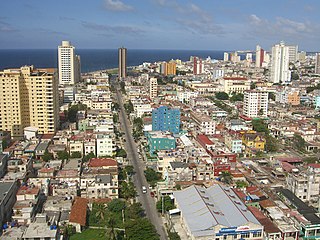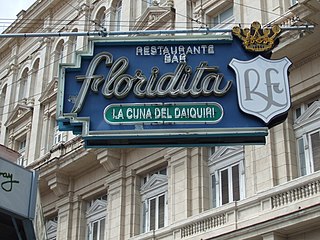
Havana is the capital and largest city of Cuba. The heart of the La Habana Province, Havana is the country's main port and commercial center. It is the most populous city, the largest by area, and the second largest metropolitan area in the Caribbean region. The population in 2012 was 2,154,454 inhabitants, and its area is 728.26 km2 (281.18 sq mi) for the capital city side and 8,475.57 km2 for the metropolitan zone.

La Habana Province, formerly known as Ciudad de La Habana Province, is a province of Cuba that includes the territory of the city of Havana, the Republic's capital. The province's territory is the seat of the superior organs of the state and its provincial administration.

The Basílica Menor of San Francisco de Asís is a Catholic minor basilica and Franciscan convent in the district of Old Havana, Cuba. Its construction began in 1548 and lasted until 1591, although it was inaugurated in 1575, it was badly damaged by storms in 1680 and 1692, and by a hurricane that broke down its tower in 1694. Started in its current form in 1716, it was completely completed almost 200 years later, with a series of structural reforms from 1731 to 1738.

Vedado is a central business district and urban neighborhood in the city of Havana, Cuba. Bordered on the east by Calzada de Infanta and Central Havana, and on the west by the Alemendares River and Miramar / Playa district, Vedado is a more modern part of the city than the areas to the east, developed in the first half of the 20th century, during the Republic period. In 2016 it was described by one commentator as the city's "most affluent" section. The main street running east to west is Calle 23, also known as "La Rampa". The northern edge of the district is the waterfront seawall known as the Malecón, a famous and popular place for social gatherings in the city. The area popularly referred to as 'Vedado' consists of the wards of Vedado, Rampa, Vedado-Malecón and Carmelo, all in the municipality of Plaza de la Revolución.

Miramar is a residential district of the municipality of Playa, in the city of Havana.

Old Havana is the city-center (downtown) and one of the 15 municipalities forming Havana, Cuba. It has the second highest population density in the city and contains the core of the original city of Havana. The positions of the original Havana city walls are the modern boundaries of Old Havana.

The Castillo de la Real Fuerza is a bastion fort on the western side of the harbour in Havana, Cuba, set back from the entrance, and bordering the Plaza de Armas. Originally built to defend against attack by pirates, it suffered from a poor location; it was too far inside the bay. The fort is considered to be the oldest stone fort in the Americas, and was listed in 1982 as part of the UNESCO World Heritage Site of "Old Havana and its Fortifications".

Eusebio Leal Spengler was a Cuban historian. He served as the municipal historian of Havana, as well as the director of the restoration project of Old Havana. Under his oversight, the historic centre of the capital city became a UNESCO World Heritage Site. He also authored books and hosted radio and television programs that recounted the city and its history.

The Palacio de los Capitanes Generales is the former official residence of the Spanish Empire's governors of Havana, Cuba, and in the Post-Colonial Period was for many time the City Hall. Located on the eastern side of the Plaza de Armas in Old Havana it is home to the Museum of the City of Havana. It houses exhibitions of art and historical artefacts and many of the rooms are preserved with their original Colonial decoration.

The Gran Hotel Manzana Kempinski La Habana is a luxury hotel in Havana, Cuba. It is located in the historic Manzana de Gómez building, an early-20th-century building that was Cuba's first shopping mall. The Kempinski Hotel chain, belongs to the oldest hotel groups in Europe, Kempinski Aktiengesellschaft.
Armando de Armas Romero was a Cuban painter.

Floridita or El Floridita is a historic fish restaurant and cocktail bar in the older part of Havana, Cuba. It lies at the end of Calle Obispo, across Monserrate Street from the National Museum of Fine Arts of Havana. The establishment is famous for its daiquiris and for having been one of the favourite hangouts of Ernest Hemingway in Havana. The bar now boasts a life size bronze statue of Ernest Hemingway positioned in his favourite spot at the end of the bar. On a small plaque hanging in El Floridita, hangs Hemingway's signed quote: "My mojito in the Bodeguita del Medio and my daiquiri in the Floridita".

The Plaza Vieja is a plaza located in Old Havana, Cuba. The plaza and its surroundings are also one of the seven consejos populares (wards) of the municipality of Old Havana. It has a residential population of 17,426.
The following is a timeline of the history of Havana, Cuba.
Radio Enciclopedia is a classical / beautiful music radio network of transmitters broadcast throughout Cuba on medium wave (AM) and VHF (FM). The main frequencies in Havana are 94.1 (FM) and 1260 (AM). It can also be heard for several hundred miles beyond Cuba's borders on 530 (AM) and worldwide via the Internet. It broadcasts soft instrumental music with occasional news and cultural programming. It is one of four main radio stations in Cuba and first broadcast on November 7, 1962.
The following is a timeline of the history of the city of Holguín, Cuba.

The Sociedad Económica de los Amigos del País de la Habana or Real Sociedad Patriótica de la Habana is a learned society in Havana, Cuba. It was initially organized to promote agriculture, commerce, education, and industry, modelled on the Sociedad Económica de los Amigos del País in Spain. Founding members included Diego de la Barrera, Francisco Joseph Basabe, José Agustín Caballero, Luis de Las Casas, Juan Manuel O'Farrill, Tomás Romay y Luis Peñalver, and Antonio Robledo. In its early decades the group produced publications, maintained a library in the Convento de Santo Domingo (1800-1844), and arranged educational programs. Around the 1790s the group built the Hospicio o Casa de Beneficencia in Havana.

The Plaza del Vapor was a covered market in Havana, it was completed in 1835. Its name derives from its builder Francisco Martí who became later the impresario of the Tacón Theatre and who had a monopoly of fish trade in the city. Martí had a painting placed against a wall from a bar of the ship El Neptuno, the first vapor that made regular round trips between Havana and Matanzas. "It was the image of that ship that ended up naming the building." From the Plaza del Vapor, Martí sold 50% of all the lottery tickets. in Cuba.

Plaza de San Francisco de Asís is a public square in the district of Old Havana, Havana, Cuba.

The Colegio de Belén is a private religious school in Marianao, Havana, located between 45th and 66th streets, next door to the Tropicana nightclub,. It was designed in 1925 by the architect Leonardo Morales y Pedroso and his brother the engineer Luis Morales y Pedroso of the firm Morales y Compañía Arquitectos.

















